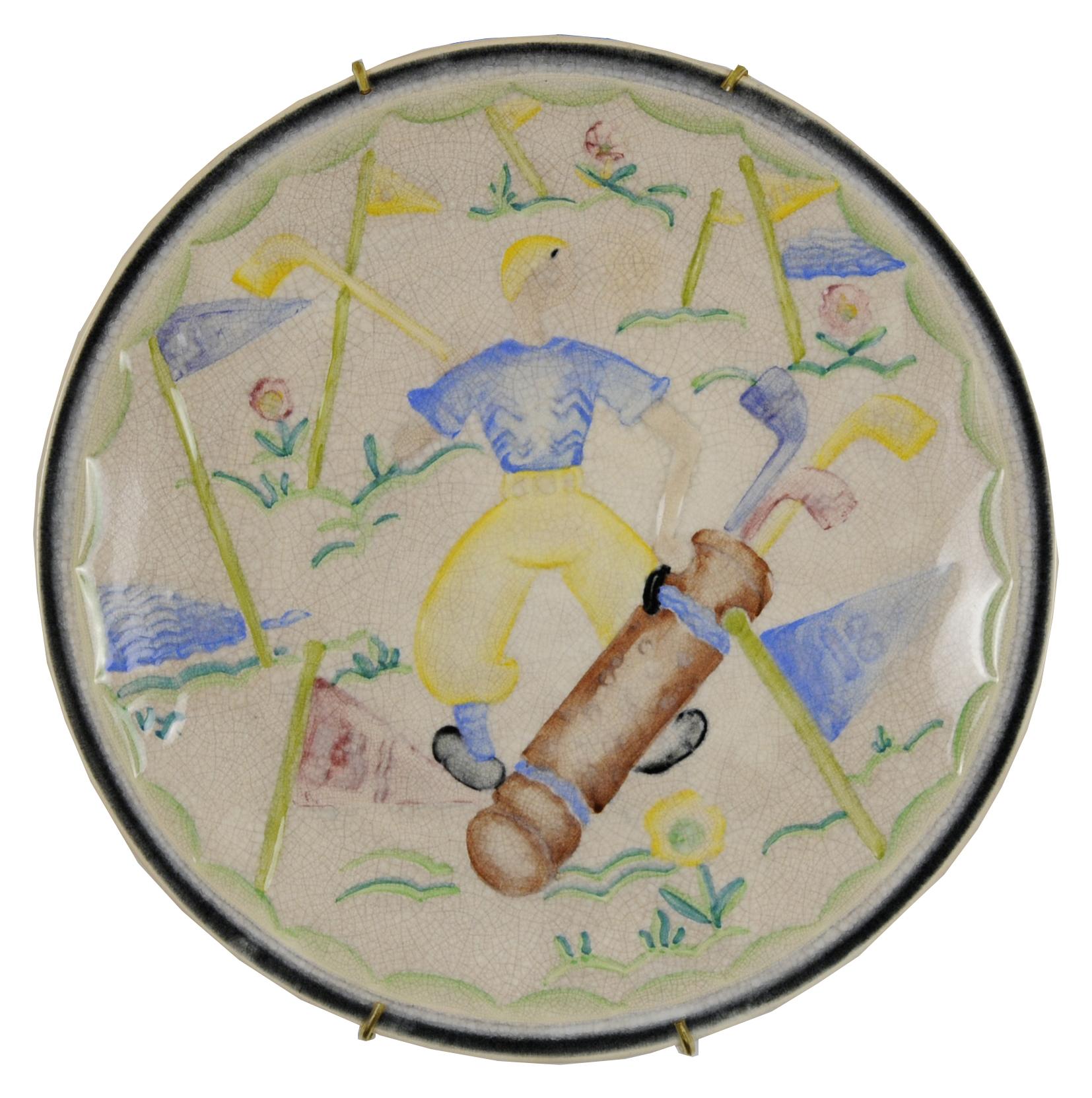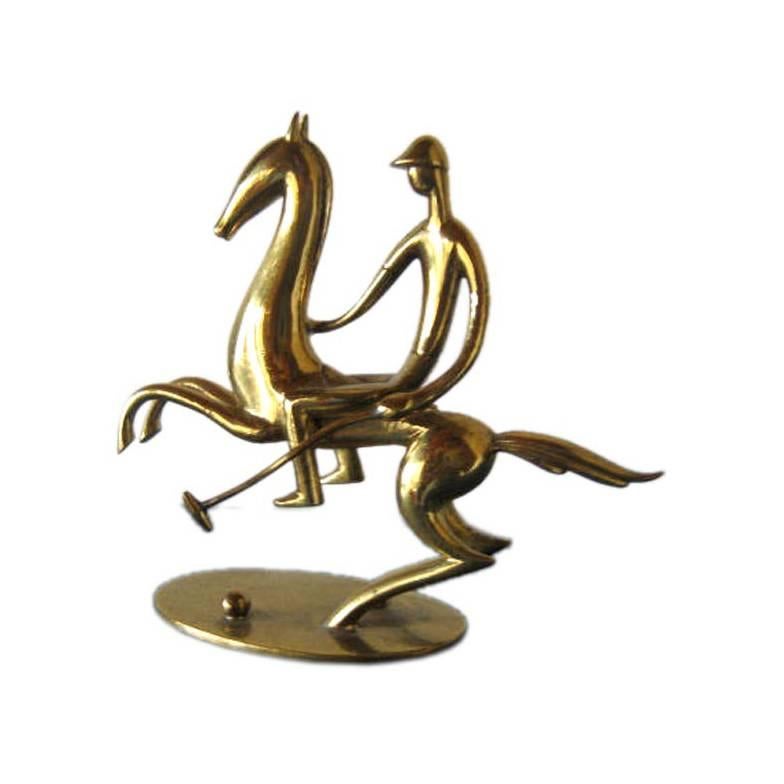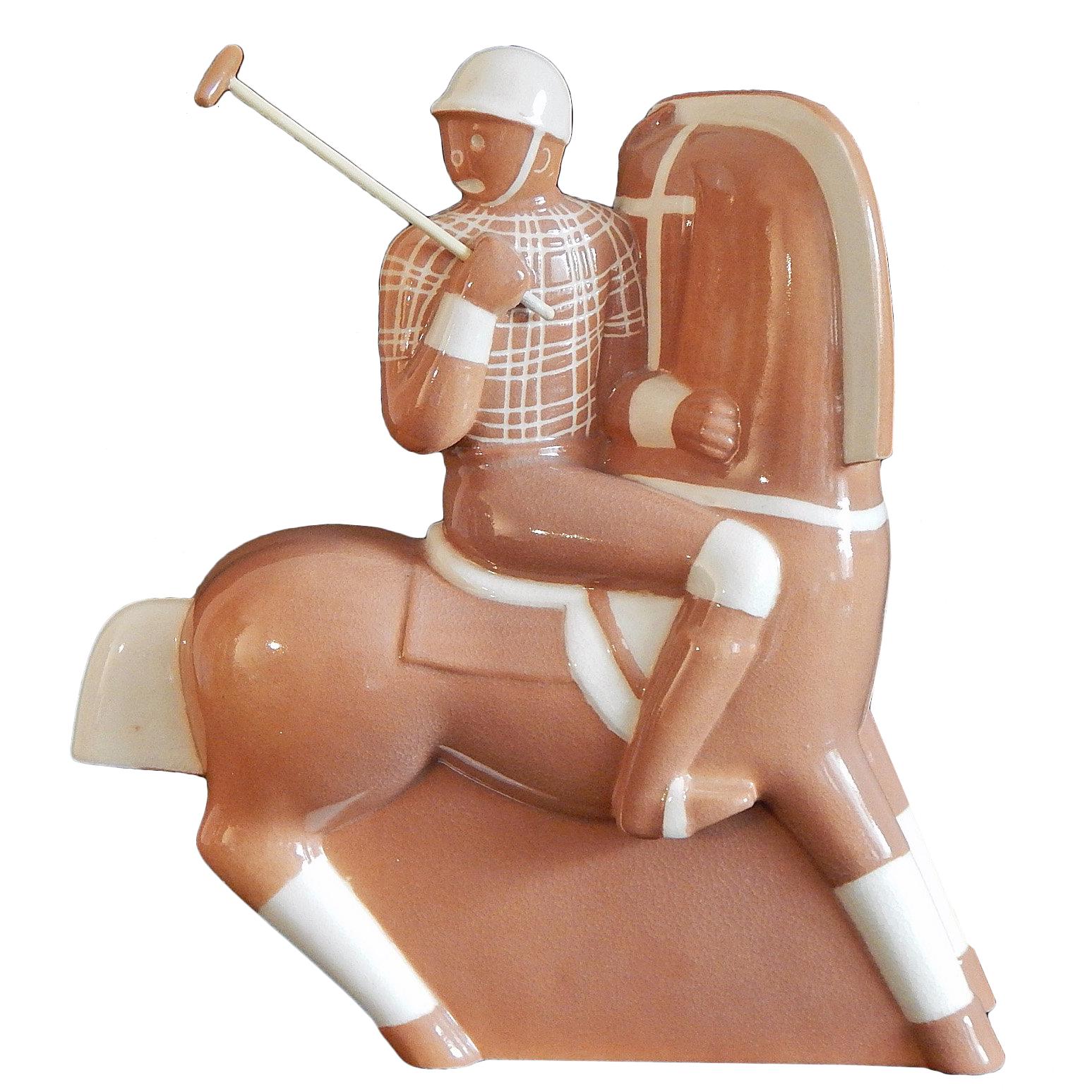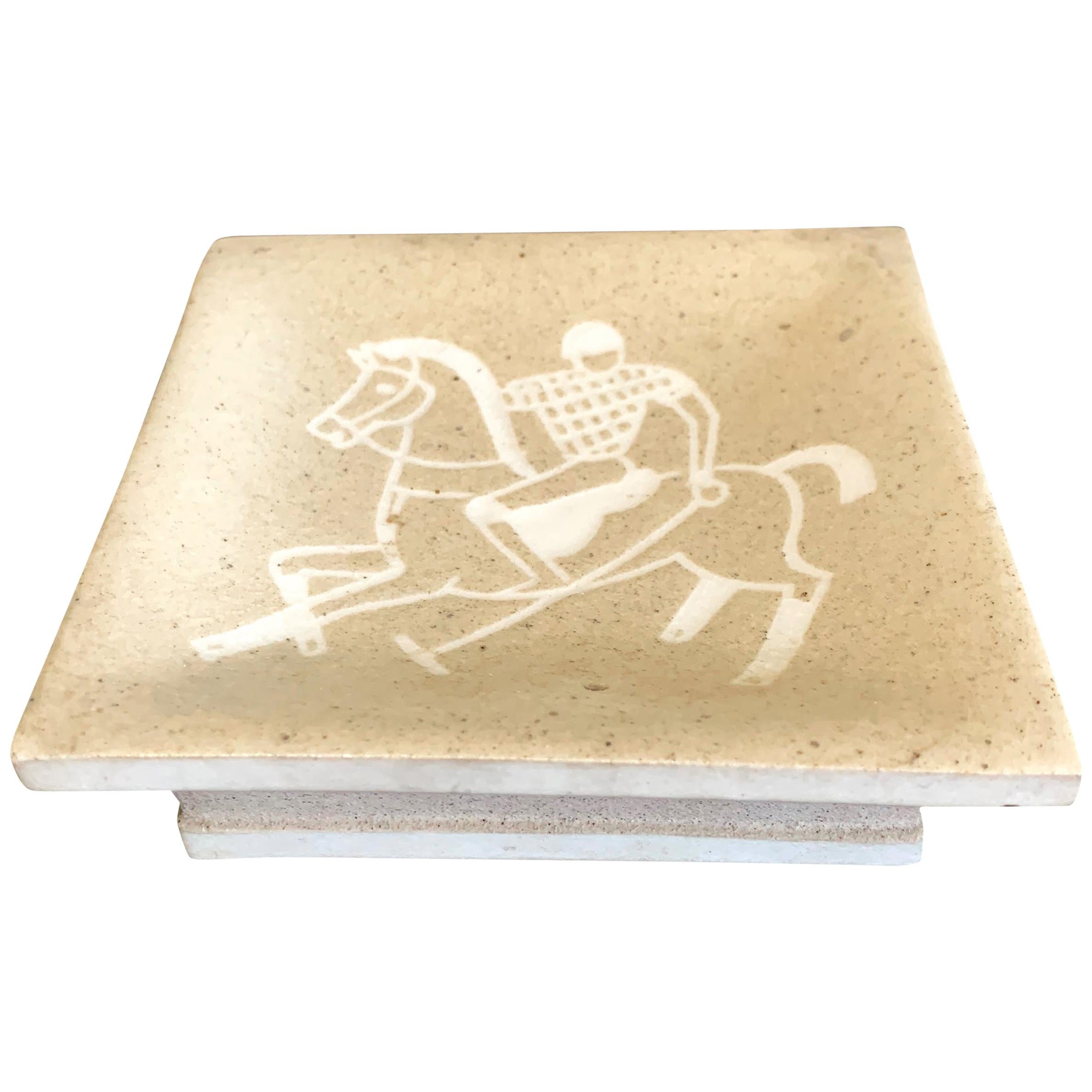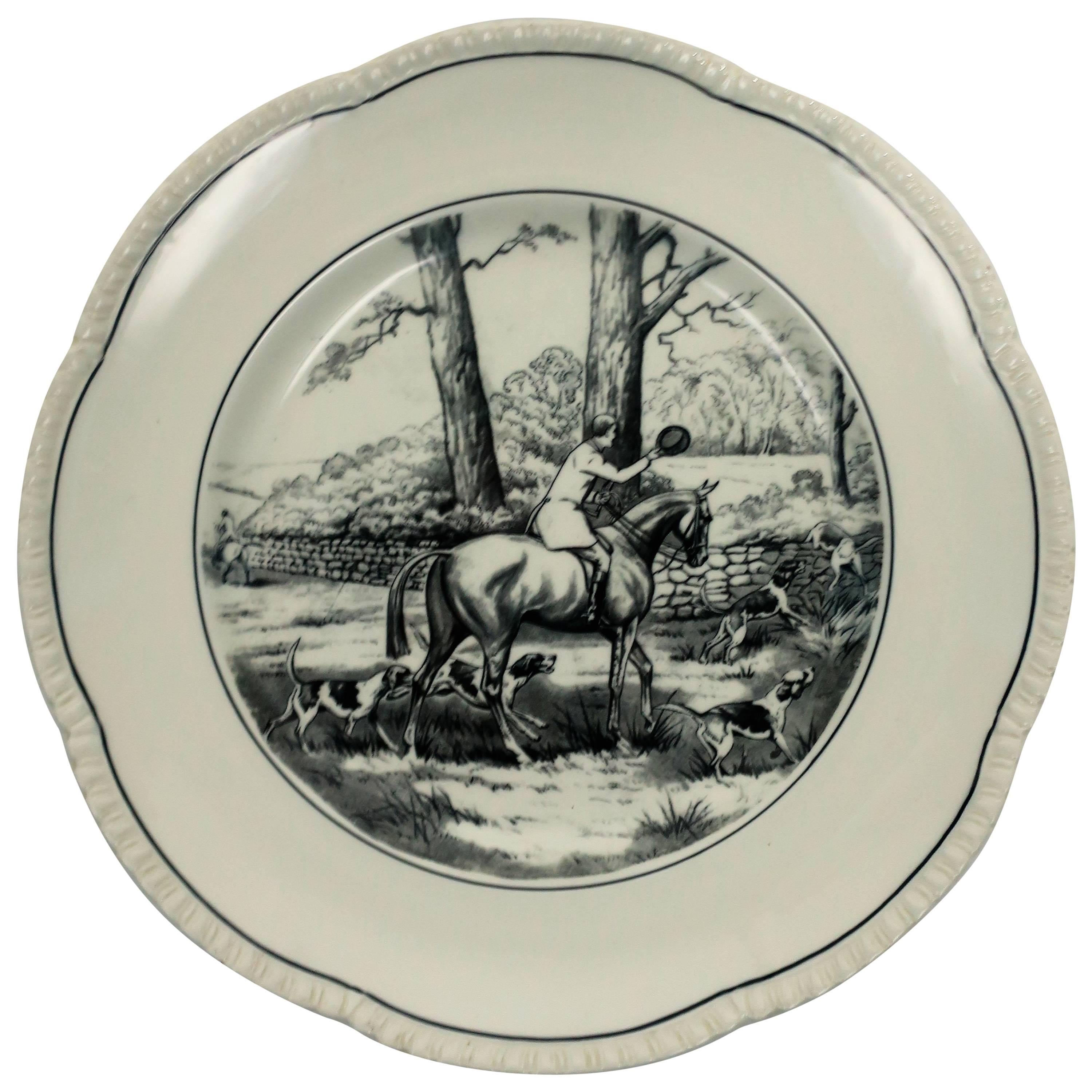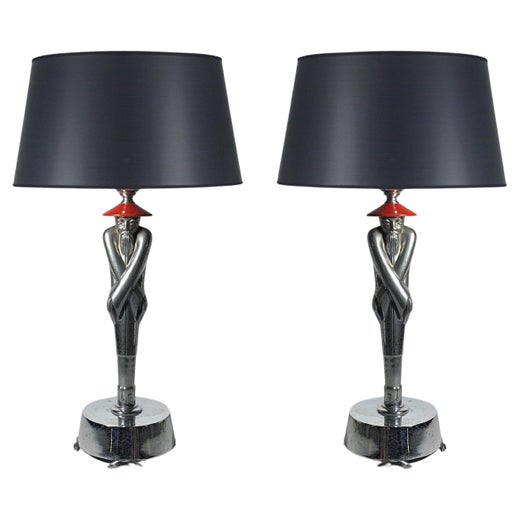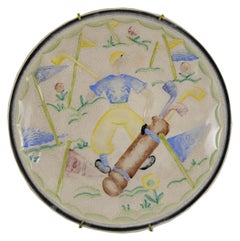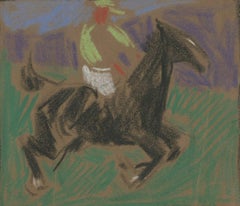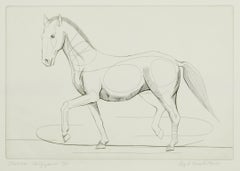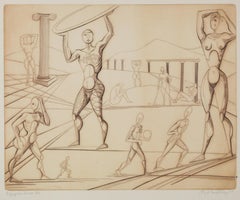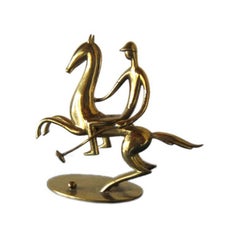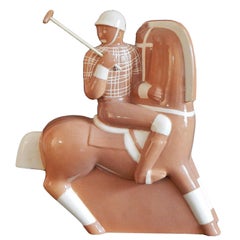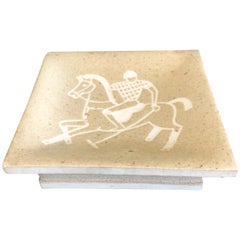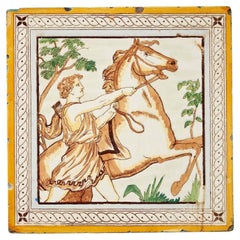Items Similar to Polo (Wall Plaque)
Want more images or videos?
Request additional images or videos from the seller
1 of 7
Viktor SchreckengostPolo (Wall Plaque)1930-31
1930-31
$3,000
£2,262.78
€2,613.53
CA$4,203.21
A$4,673.72
CHF 2,446.78
MX$57,090.42
NOK 30,746.19
SEK 28,922.95
DKK 19,509.80
About the Item
Polo (Wall Plaque)
Polychromed ceramic, c. 1930-1931
Signed with the artist's initials: VS recto
Cowan Pottery stamp verso
References And Exhibitions:
Designed by the artist while working for Cowan Pottery in 1930. One of Cowan's clients, an interior designer, requested plates decorated with different outdoor activities. Others in the series included "Swimming," "Tennis," "Golf," and "The Hunt."
Condition: with the usual craquelure
Size: 11 1/4 inches in diameter
Industrial design democratizes high style, and Mr. Schreckengost was widely considered among the most democratic industrial designers. He made, quite literally, the stuff of life — things found routinely in homes, backyards and garages in this country and around the world. He designed bicycles for Sears and everyday china for American Limoges. He designed children’s toys and pedal cars; flashlights, furniture and fans; lawn chairs, lawn mowers and golf carts; baby walkers and artificial limbs.
In 2006 Mr. Schreckengost was awarded the National Medal of Arts, the country’s highest cultural honor. His work is in the permanent collection of major museums, including the Renwick Gallery, the Cooper-Hewitt National Design Museum and the Art Institute of Chicago.
Mr. Schreckengost belonged to the first great generation of American industrial designers, which included luminaries like Russel Wright, Norman Bel Geddes and Raymond Loewy.
The lights of New York did, however, inspire his most famous piece, the “Jazz” bowl, commissioned by an anonymous client in 1930. Originally trained as a ceramicist, Mr. Schreckengost was then working for the Cowan Pottery Studio in Rocky River, Ohio. One day he picked up what looked like a routine order for a punch bowl with a New York theme. The client, a woman named Eleanor, was delighted with the bowl, Mr. Schreckengost learned. Her husband, Franklin, liked it too. Mrs. Roosevelt, then the first lady of New York State, ordered two more “Jazz” bowls from Mr. Schreckengost, one for her home in Hyde Park, another for a house on Pennsylvania Avenue in Washington that she fully expected to occupy in 1933.
Widely photographed, the “Jazz” bowls are considered signal examples of Art Deco style. In 2004 Sotheby’s sold one of the $50 bowls at auction for $254,400.
- Creator:Viktor Schreckengost (1906, American)
- Creation Year:1930-31
- Dimensions:Height: 11.25 in (28.58 cm)Diameter: 11.25 in (28.58 cm)
- Medium:
- Movement & Style:
- Period:
- Condition:
- Gallery Location:Fairlawn, OH
- Reference Number:Seller: FA73281stDibs: LU14010197462
Viktor Schreckengost
The son of a commercial potter in Sebring, Ohio, Viktor Schreckengost learned the craft of sculpting in clay from his father. In the mid-1920s, he enrolled at the Cleveland School of Art (now the Cleveland Institute of Art, or CIA) to study cartoon making, but after seeing an exhibition at the Cleveland Museum of Art he changed his focus to ceramics. Upon graduation in 1929, he studied ceramics in Vienna, Austria, where he began to build a reputation, not only for his art, but also as a jazz saxophonist. A year later, at the age of 25, he became the youngest faculty member at the CIA. In 1931, Schreckengost won the first of several awards for excellence in ceramics at the Cleveland Museum of Art, and his works were shown at the Metropolitan Museum of Art, the Art Institute of Chicago, the Panama-Pacific Exposition in San Francisco, and elsewhere. By the mid-1930s, Schreckengost had begun to pursue his interest in industrial design. For American Limoges, he created the first modern mass-produced dinnerware, called Americana. Along with engineer Ray Spiller, Schreckengost designed the first-cab-over-engine truck for Cleveland's White Motor Company. By the end of the decade, he had designed the first Mercury Bicycle for Murray, Ohio. In 1939, the bicycle and "The Four Elements" in clay were displayed at the New York World's Fair. In the 1940s, Schreckengost's designs for children's pedal cars (as well as bicycles and toys) helped Murray, Ohio become the world's largest manufacturer of pedal cars. His design and ceramic work was interrupted by World War II, when he was recruited by the Navy to develop a system for radar recognition that won him the Secretary of Navy's commendation. After the war, Schreckengost resumed his industrial design career creating products for Murray, Sears, General Electric, Salem China Company, and Harris Printing, among others. Approximately 100 million of his bicycles were manufactured by Murray, making it the largest bicycle-maker in the world. He retired from industrial design in 1972, but continued teaching at the Cleveland Institute of Art. Biography from the Archives of askART In June, 2006, Viktor Schreckengost celebrated his 100th birthday in Cleveland Heights, Ohio. Of him at this event, it was written: Viktor Schreckengost, a prolific designer whose works ranging from toys, ceramics and paintings to dinnerware and trucks, have touched countless lives, expects his next inspiration to come at any time. . . (he) always seemed to know what to create by responding to needs---like improving the ride of a child's wagon or making user-friendly tableware with an artistic flair." To recognize his birthday, more than 130 galleries and museums featured his work the summer of 2006 in a "National Centennial Exhibition" that paid tribute to his legacy that "includes generations of students who became designers who shaped the output of industrial America in the post World-War II era." In February 2008, Victor Schreckengost died at age 101 at Tallahassee, Florida, where he was spending the winter.
About the Seller
5.0
Recognized Seller
These prestigious sellers are industry leaders and represent the highest echelon for item quality and design.
Platinum Seller
Premium sellers with a 4.7+ rating and 24-hour response times
Established in 1978
1stDibs seller since 2013
808 sales on 1stDibs
Typical response time: <1 hour
Associations
International Fine Print Dealers Association
- ShippingRetrieving quote...Shipping from: Fairlawn, OH
- Return Policy
Authenticity Guarantee
In the unlikely event there’s an issue with an item’s authenticity, contact us within 1 year for a full refund. DetailsMoney-Back Guarantee
If your item is not as described, is damaged in transit, or does not arrive, contact us within 7 days for a full refund. Details24-Hour Cancellation
You have a 24-hour grace period in which to reconsider your purchase, with no questions asked.Vetted Professional Sellers
Our world-class sellers must adhere to strict standards for service and quality, maintaining the integrity of our listings.Price-Match Guarantee
If you find that a seller listed the same item for a lower price elsewhere, we’ll match it.Trusted Global Delivery
Our best-in-class carrier network provides specialized shipping options worldwide, including custom delivery.More From This Seller
View AllGolf (Wall Plaque)
By Viktor Schreckengost
Located in Fairlawn, OH
Golf (Wall Plaque)
Polychromed ceramic, c. 1930-1
Signed with the artist's initials: VS recto
Very rare, only a few produced prior to the closure of Cowan Pottery
Format: Round ceramic plate, 11 1/4 inches
Designed by the artist while working for Cowan Pottery in 1930. One of Cowan's clients, an interior designer, requested plates decorated with different outdoor activities. Others in the series included "Swimming," "Tennis," "Polo," and "The Hunt."
According to Henry Adams, the number of examples created was very limited due to the closing of Cowan Pottery in 1931. Very rare
Condition: Good, with the usual craquelure of the glazes used.
Note: Industrial design democratizes high style, and Mr. Schreckengost was widely considered among the most democratic industrial designers. He made, quite literally, the stuff of life — things found routinely in homes, backyards and garages in this country and around the world. He designed bicycles for Sears and everyday china for American Limoges...
Category
1930s Art Deco Figurative Sculptures
Materials
Ceramic
untitled (polo player on horseback)
By Henry George Keller
Located in Fairlawn, OH
untitled (polo player on horseback)
Chalk on tan paper, c. 1920
Unsigned
Provenance: Gift of the artist
William McGill (Keller's student)
Image size: 4 3/8 x 5 ...
Category
1920s American Impressionist Animal Drawings and Watercolors
Materials
Chalk
Vienna Lipizzaner
By Ray H. French
Located in Fairlawn, OH
Vienna Lipizzaner
Engraving, 1962
Signed and dated lower right (see photo)
Titled and numbered lower left (see photo)
This impression is from the second edtition printed c. 1992
1st ...
Category
1960s American Modern Animal Prints
Materials
Engraving
Olympian Games
By Ray H. French
Located in Fairlawn, OH
Olympian Games
Engraving, 1957
Signed, dated, titled and numbered (see photos)
Edition: 25 (7/25)
From the first and only edition, probably less than 8 impressions printed
Printed by the artist
Condition: Excellent
soft fold in upper left margin
Image size: 15 7/8 x 19 7/8 inches
Sheet size: 18 1/2 x 22 3/8 inches
Provenance: Estate of the artist
Martha A. French Revocable Trust
Item Reference
LU14013763732
Crucifixion, color etching, 1947
Item Reference
LU14013160582
The Web, engraving, 1950
Item Reference
LU14011892032
The Swan, mixed media (etching & soft ground), 1957
Item Reference
LU1404294651
Snowy Egret, engraving, 1954, third edition c. 1990, printed by the master printer Jon Clemens
Item Reference
LU1402253433
Debris, color etching, c. 1940, printed by the artist at the John Herron Art Institute, Indianapolis, Indiana
Item Reference
LU140331242
Crucifixion, engraving, 1958
Item Reference
LU140145330
Strange Animals, engraving, 1947
Item Reference
G130708140172
The Gull, engraving, 1955
Item Reference
LU14012448972
Moon Rays...
Category
1950s American Modern Figurative Prints
Materials
Engraving
Honoring the Pony Express (1860-1960)
By Norbert Lenz
Located in Fairlawn, OH
Signed in image lower left; Label verso #196
From Lenz's House of Farnam "First Day" Cover Series
Painter, illustrator and commercial artist Norbert Lenz was born in Norwalk, Ohio...
Category
20th Century Mixed Media
Materials
Mixed Media
Untitled (also known as "1811 THE BACKWOODSMAN'S CHRISTMAS")
Located in Fairlawn, OH
Untitled (also known as "1811 THE BACKWOODSMAN'S CHRISTMAS")
Oil on canvas, c. 1875-1925
Unsigned
Provenance: Found in Ohio
A charming American naive nocturn of a hunter and his two ...
Category
1870s Outsider Art Landscape Paintings
Materials
Oil
You May Also Like
Hagenauer Polo Player
Located in St.Petersburg, FL
A wonderful stylized Art Deco polo player sculpture. Signed Hagenauer, Wien.
Category
Vintage 1930s Austrian Art Deco Sculptures
Materials
Bronze
$1,500
"Polo Player, " Classic and Rare Art Deco Sculpture in Caramel Hue by Gregory
By Waylande Gregory
Located in Philadelphia, PA
One of the rarest and most classic Art Deco sculptures ever produced in 1930s America, this striking Polo Player, complete with his original polo mallet, was sculpted by Waylande Gre...
Category
Vintage 1930s American Art Deco Figurative Sculptures
Materials
Porcelain
"Polo Player, " Footed, Shallow Dish with Polo Motif, Art Deco, by Gregory
By Waylande Gregory
Located in Philadelphia, PA
Beautifully glazed in shades of white and sand, this rare footed dish depicts a polo player reaching out to strike the ball. The primary glaze has a beautiful mottled appearance, and...
Category
Vintage 1930s American Art Deco Decorative Bowls
Materials
Clay
Reclaimed Mythological Tile by Minton Hollins
By Minton
Located in Wormelow, Herefordshire
A reclaimed 8-inch clay tile by Minton Hollins & Co. (stamped to reverse) illustrated with a mythological scene from Shakespeare’s 1593 poem ‘Venus and Adonis’. Inspired by Greek myt...
Category
Antique Late 19th Century English Neoclassical Mounted Objects
Materials
Clay
English Porcelain Plate or Wall Art with Horse Scence
Located in New York, NY
A beautiful black and off-white English porcelain plate depicting a country scene with horse, hunting dogs, and fowl birds. With maker's mark: Royal Caultron, England, est. 1774. Ver...
Category
Early 20th Century English Porcelain
Materials
Faience, Pottery, Ceramic, Delft, Porcelain
Scène de Tauromachie
By Pablo Picasso
Located in CANNES, FR
Pablo Picasso ( Ceramic work made in Vallauris .France )
"Scène de tauromachie " model created 11 June 1959 ,
numbered 54 / 100 . Mint Condition .Original work edited in a series of ...
Category
1950s Modern Figurative Sculptures
Materials
Ceramic
More Ways To Browse
Outdoor Wall Art Vintage
Award Plaque
Golf Sculpture
Studio Pottery Wall Art
Toy Train
Pottery Plaque
Art Deco Golf
Limoges Art Deco
Lady With A Fan
Outdoor Ceramic Sculpture
Art Deco Furniture By Jazz
Lawn Chair
Baby Toys
Mr And Mrs Vintage Furniture
Tennis Sculpture
American Limoges
Sears Vintage Furniture
Vintage Hunt Country Furniture
